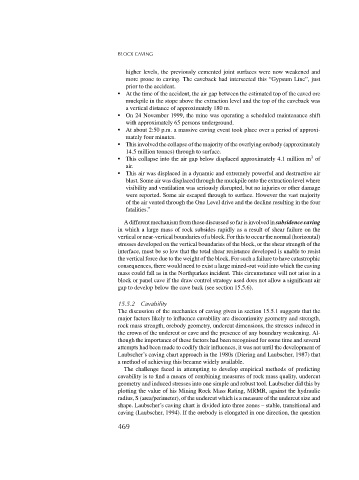Page 487 - Rock Mechanics For Underground Mining
P. 487
BLOCK CAVING
higher levels, the previously cemented joint surfaces were now weakened and
more prone to caving. The caveback had intersected this “Gypsum Line”, just
prior to the accident.
At the time of the accident, the air gap between the estimated top of the caved ore
muckpile in the stope above the extraction level and the top of the caveback was
a vertical distance of approximately 180 m.
On 24 November 1999, the mine was operating a scheduled maintenance shift
with approximately 65 persons underground.
At about 2:50 p.m. a massive caving event took place over a period of approxi-
mately four minutes.
This involved the collapse of the majority of the overlying orebody (approximately
14.5 million tonnes) through to surface.
This collapse into the air gap below displaced approximately 4.1 million m of
3
air.
This air was displaced in a dynamic and extremely powerful and destructive air
blast. Some air was displaced through the muckpile onto the extraction level where
visibility and ventilation was seriously disrupted, but no injuries or other damage
were reported. Some air escaped through to surface. However the vast majority
of the air vented through the One Level drive and the decline resulting in the four
fatalities.”
A different mechanism from those discussed so far is involved in subsidence caving
in which a large mass of rock subsides rapidly as a result of shear failure on the
vertical or near-vertical boundaries of a block. For this to occur the normal (horizontal)
stresses developed on the vertical boundaries of the block, or the shear strength of the
interface, must be so low that the total shear resistance developed is unable to resist
the vertical force due to the weight of the block. For such a failure to have catastrophic
consequences, there would need to exist a large mined-out void into which the caving
mass could fall as in the Northparkes incident. This circumstance will not arise in a
block or panel cave if the draw control strategy used does not allow a significant air
gap to develop below the cave back (see section 15.5.6).
15.5.2 Cavability
The discussion of the mechanics of caving given in section 15.5.1 suggests that the
major factors likely to influence cavability are discontinuity geometry and strength,
rock mass strength, orebody geometry, undercut dimensions, the stresses induced in
the crown of the undercut or cave and the presence of any boundary weakening. Al-
though the importance of these factors had been recognised for some time and several
attempts had been made to codify their influences, it was not until the development of
Laubscher’s caving chart approach in the 1980s (Diering and Laubscher, 1987) that
a method of achieving this became widely available.
The challenge faced in attempting to develop empirical methods of predicting
cavability is to find a means of combining measures of rock mass quality, undercut
geometry and induced stresses into one simple and robust tool. Laubscher did this by
plotting the value of his Mining Rock Mass Rating, MRMR, against the hydraulic
radius, S (area/perimeter), of the undercut which is a measure of the undercut size and
shape. Laubscher’s caving chart is divided into three zones – stable, transitional and
caving (Laubscher, 1994). If the orebody is elongated in one direction, the question
469

